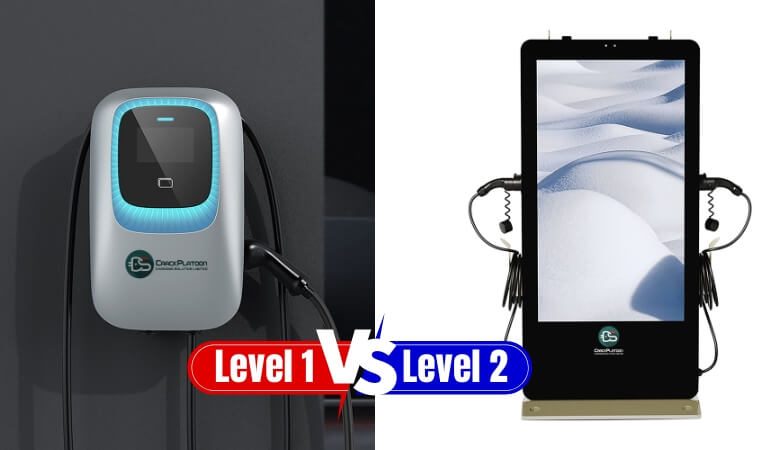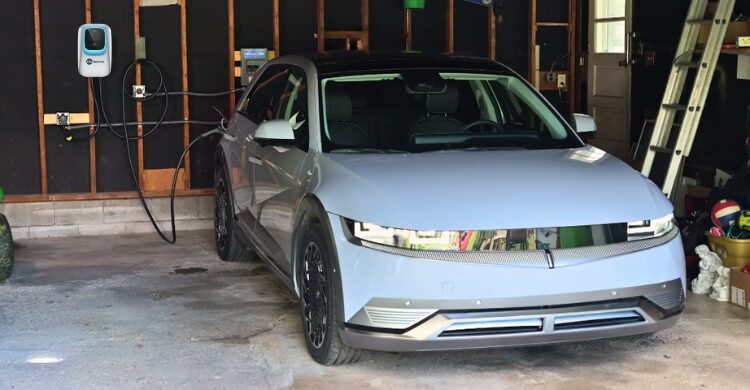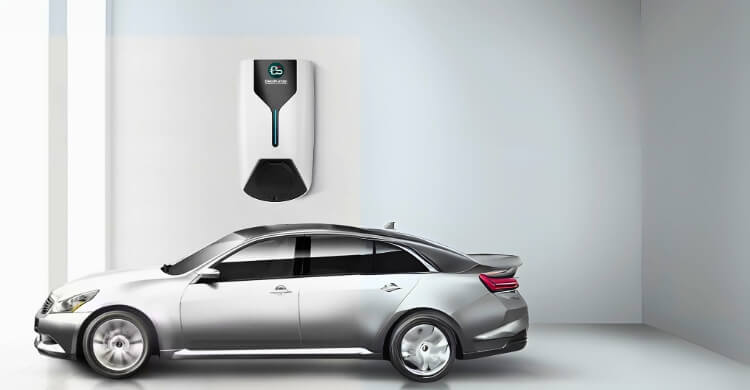You can stay on the road efficiently and reliably when you use electric vehicle (EV) chargers. There are two types of EV chargers that are the most common: Level 1 and Level 2. These chargers fit different charging needs and setups. But what is the difference between a Level 1 and Level 2 EV charger?
The main difference between a Level 1 and Level 2 EV charger is the power source. Level 1 chargers use standard 120-volt outlets for slower charging, while Level 2 chargers use 240-volt outlets, offering significantly faster charging times.
Throughout this article, we’ll explore how these chargers work, their strengths and weaknesses, and which one is right for you. So stay with us.
What Is the Difference Between a Level 1 and Level 2 EV Charger? Find Out Here!
Electric vehicle (EV) chargers are important tools for keeping your car powered up. Depending on your needs, you can choose between Level 1 and Level 2 chargers. Understanding the differences between them can help you make the right choice for your home.

Power Source
Level 1 chargers use a standard 120-volt electrical outlet, the same type used for household appliances. This is the most basic form of EV charging. On the other hand, Level 2 chargers require a 240-volt outlet, often found in home electric dryers. The higher voltage of Level 2 chargers means faster charging times.
While Level 1 chargers are widely available in most homes, their slower charging speed can be a limitation. For many, using a Level 1 charger overnight might be enough to power the EV for daily use. Level 2 chargers, though, are more powerful and can recharge an EV much faster. They are better suited for people who need a quicker turnaround time between uses.
Charging Speed
One of the most significant differences between Level 1 and Level 2 chargers is their charging speed. Level 1 chargers typically add about 3 to 5 miles of range per hour. This can be fine if you drive short distances or only need a top-up overnight.
In contrast, Level 2 chargers add roughly 10 to 60 miles of range per hour, depending on the charger and car. This means this type of charger is much more efficient for long commutes or when you’re in a rush. Level 1 chargers work best for people who don’t mind a slower process. However, if time is a factor, Level 2 is the more efficient option.
Installation Process
Setting up a Level 1 charger is simple because it plugs directly into a standard 120-volt outlet. Most homes are already equipped with these outlets, making it an easy option for most EV owners. You don’t need to hire a professional to install this type of charger, making it a cost-effective solution.
For a Level 2 charger, installation is a bit more involved. A licensed electrician may need to install a 240-volt outlet in your garage or driveway. While it can be an upfront cost, many people find the convenience of faster charging worthwhile. In terms of ease of use, Level 2 chargers are just as simple to use as Level 1 chargers.
Charging at Home vs. Public Spaces
Level 1 chargers are most commonly used at home, where there’s no rush and charging can happen overnight. They are simple and don’t require any special equipment beyond the charger itself. Public places rarely offer Level 1 chargers since they are slower and not suited for quick stops. At home, though, they work well for daily top-ups.
Level 2 chargers are common both at home and in public locations like malls and parking garages. In growing countries like Bangladesh, where electric vehicles are gradually gaining popularity, public infrastructure is expanding to support faster charging. That’s why electric vehicle charging stations in Bangladesh are increasingly including Level 2 chargers to meet daily commuting needs. This makes it easier for EV owners to recharge quickly while out and about, just like in more developed charging networks.
Ideal Use Cases
People with low daily driving needs or those who can charge overnight should use level 1 chargers. If your commute is short and you have time to charge slowly, this option is great. It’s perfect for people who don’t mind waiting for their car to charge.
However, Level 2 chargers are ideal for those who drive longer distances daily or have limited time to charge. They’re also great for families with multiple EVs or people who use their cars frequently. If you need fast, efficient charging, investing in a Level 2 charger could be the right choice. It’s the best option for a fast-paced lifestyle.
When Should You Use a Level 1 EV Charger?
Level 1 chargers are the most basic type of charging for electric vehicles (EVs). They are easy to use and connect to a standard home outlet. While they are slower, they still serve an important role for many EV owners. Here’s when you should consider using a Level 1 charger.

For Overnight Charging at Home
Charging overnight works well when you’re not in a hurry to use your car. Level 1 chargers provide a steady charge while you sleep. Most people wake up to a ready-to-go vehicle in the morning. This method suits daily routines with no urgent travel plans.
When Fast Charging Isn’t Necessary
Some drivers don’t need their vehicle charged in just a few hours. Taking time and understanding Level 1 chargers can help set realistic expectations. Many EV owners find this pace works fine for regular errands or work commutes. It’s a relaxed, stress-free way to keep the battery topped up.
In Homes Without Special Installations
Level 1 chargers use standard 120-volt outlets found in almost every home. There’s no need for new wiring or big upgrades. This makes it perfect for apartments, rentals, or older houses. Just plug in and start charging without any hassle.
For Local Driving and Short Trips
Short daily trips usually don’t use much battery power. A Level 1 charger can easily refill that small amount overnight. It’s great for school runs, grocery shopping, or neighborhood visits. Most EVs stay fully charged with this routine.
When Keeping Costs Low
Using a Level 1 charger helps avoid extra expenses. There’s no need to buy advanced equipment or hire an electrician. This makes it a smart choice for anyone watching their budget. Simple charging with no added setup cost is a big plus.
For Occasional Vehicle Use
Some people don’t use their EV every single day. A slow charger works just fine to maintain battery levels over time. It keeps the vehicle ready for weekend drives or special errands. There’s no need to rush the charge when the car isn’t used often.
Home Charging vs. Public Charging: Which Is Better?
Both home charging and public charging help keep your electric vehicle ready to go. But each has its own pros and cons. Let’s break it down in a simple table so you can decide what works best for you.
| Point | Home Charging | Public Charging |
| 1. Convenience | Very convenient—you can charge while relaxing or sleeping. | Depends on finding a nearby station and waiting for a spot. |
| 2. Charging Speed | Usually slower unless you install a Level 2 charger. | Often faster with access to rapid or DC fast chargers. |
| 3. Cost Per Charge | Usually cheaper because of standard electricity rates. | Often more expensive than charging at home. |
| 4. Availability | Always available at your own place. | May be occupied or far from your location. |
| 5. Setup Requirements | Needs a plug and possibly a home charger installed. | No setup—just drive up and plug in. |
| 6. Time Flexibility | Charge anytime, no need to wait in line. | Might need to plan your time around charging station access. |
| 7. Long Trip Suitability | Not ideal for long road trips without breaks. | Better for quick top-ups during long journeys. |
| 8. Battery Maintenance | Regular, slow charging is good for battery health. | Frequent fast charging may wear the battery faster over time. |
| 9. Upfront Cost | May need to buy a charger or install wiring at home. | No upfront cost, just pay when you charge. |
| 10. Use Case | Great for daily, local driving needs. | Useful for travel, emergencies, or when you’re away from home. |
Why Do Some EV Owners Look Beyond Level 2 Charging Solutions?
EV chargers at Level 2 are popular because they are faster than chargers at Level 1, and they are easy to install at home. Still, some EV owners are exploring more advanced options. Let’s look at why they’re going beyond Level 2 and what they’re aiming for.
Wanting Even Faster Charging
Long trips and a busy schedule make time a priority for drivers. Some want to charge their cars in just minutes, not hours. That’s why they’re turning to DC fast chargers, also known as Level 3 chargers, which provide ultra-rapid charging. The concept of a level 3 EV charging station brings an advanced solution for drivers who prioritize speed and minimal downtime during charging.
Preparing for Long-Distance Travel
Daily charging is fine for local use, but road trips need faster, stronger charging. Level 2 chargers may not meet those needs. On highways, drivers look for high-speed stations to stay on schedule. That makes faster options more appealing for long journeys.
Owning High-Performance EVs
Some modern EVs support higher charging rates than Level 2 provides. Owners want to take full advantage of that feature. They prefer chargers that match their car’s fast-charging abilities. It feels like wasting potential when the car can do more.
Saving Time During Busy Days
Every minute counts during packed schedules and daily errands. Waiting hours for a charge may not be practical for some people. Fast charging offers more flexibility with less downtime. It helps owners keep moving without major delays.
Access to Public Fast-Charging Networks
More cities are building quick charging networks for public use. That gives drivers easy access to faster charging on the go. When fast chargers are nearby, they’re hard to ignore. People naturally prefer quicker options when available.
Planning for Future EV Upgrades
As EVs evolve, charging needs change too. Some owners want to stay ready for cars with faster charging features. They’re thinking ahead and future-proofing their setup. It’s all about being prepared for what’s coming next.
Is There a Major Cost Difference Between Level 1 and Level 2 Chargers?
Yes, there is a major cost difference between Level 1 and Level 2 chargers for electric vehicles. Level 1 chargers usually come with the car, so there’s no need to buy extra equipment. They plug into a normal home outlet, which means no special setup is required. That makes them the cheaper choice, especially for first-time EV owners.
Level 2 chargers require a separate unit that you’ll need to purchase on your own. They also need a 240-volt outlet installed at home. Hiring a professional electrician is often necessary, which adds to the overall cost. Though faster, the setup and hardware make them more expensive than Level 1 chargers.
Despite the cost, many people still choose Level 2 chargers for the speed and convenience they offer. Paying more up front often saves time later, especially for busy drivers. Level 1 works fine for short trips and overnight charging without any upgrades. But for faster charging, Level 2 is the better long-term investment for many EV users.
How to Maximize Charging Efficiency with the Right Setup?
A smart setup can help your electric vehicle charge faster and save energy. With a few simple changes, you’ll get better results. Let’s explore easy ways to boost charging efficiency at home or on the go.

Choose the Right Charger for Your Needs
Picking the charger that suits your daily driving habits makes a big difference. Not everyone needs the fastest option available right away. Level 1 works fine for short trips and overnight charging. Level 2 is better for busy drivers needing faster top-ups.
Install Your Charger in a Convenient Location
Placing your charger where it’s easy to access helps save time and effort. A nearby garage wall or driveway spot works best. You’ll avoid long cords or repeated parking adjustments every day. A simple setup means fewer steps and faster plug-in time.
Charge During Off-Peak Electricity Hours
Many utility companies offer cheaper electricity at night or early morning hours. Charging your EV during these times saves money and energy. This also reduces stress on the power grid during busy daytime hours. You benefit while helping the environment too.
Keep Your Battery Between 20% and 80%
Charging from empty to full isn’t always the most efficient option. Batteries last longer when kept in a mid-range charge level. Staying between 20% and 80% helps maintain battery health and speed. This small habit adds up over time.
Monitor Charging with Smart Apps
Many chargers come with apps that show charging speed, battery level, and timing. Checking this data helps adjust your routine easily. You’ll see what works best and what slows things down. Making small changes improves the overall experience quickly.
Avoid Frequent Use of Fast Charging
Fast charging is useful but not always the best for long-term battery life. It generates heat and adds stress to the battery. Use it when needed, not for every charge session. Balancing your charging methods helps your battery stay strong longer.
FAQs About What Is the Difference Between a Level 1 and Level 2 EV Charger?
With so many options available for EV charging, it can be confusing. To make your decision easier, we’ve prepared a list of frequently asked questions. With these answers, you will be able to understand the key differences between Type 1 and Type 2 EV chargers and be able to choose the best one for your needs.
Can a Level 1 Charger Be Used for Longer Trips?
While Level 1 chargers can handle short trips, they are not ideal for long-distance travel. Their slower charging speeds may require extended charging times, which may not be practical on longer journeys. Level 2 chargers are better suited for fast recharges during long trips.
Is It Possible to Use a Level 2 Charger With a Level 1 Car?
Yes, you can use a Level 2 charger with a Level 1 car, but the car will only charge at its Level 1 rate. The car’s charging system limits the speed to what it’s designed for, so using a faster charger doesn’t necessarily speed things up for older or less capable vehicles.
How Long Does It Take to Charge an EV With a Level 1 Charger?
The charging time with a Level 1 charger can vary based on the EV’s battery capacity. On average, it may take between 12 to 24 hours to fully charge an EV, which is fine for overnight use. This slower rate is typically sufficient for daily short trips.
What Are the Safety Concerns When Using a Level 1 Charger?
Level 1 chargers are safe when used correctly. They simply plug into a standard outlet, but it’s important to ensure that the electrical wiring in your home can handle the load. Regular inspection of your charger and outlet will help prevent electrical issues or accidents.
What Are the Environmental Benefits of Using Level 2 Chargers?
Level 2 chargers are more efficient, reducing the total energy consumption required for each charging cycle. By reducing charging time and minimizing energy waste, they can help reduce the overall environmental footprint of EV usage. This leads to better overall energy use, especially in high-demand areas.
Are Level 2 Chargers Compatible With All EVs?
Most EVs are compatible with Level 2 chargers, but there are some exceptions. It’s essential to check the car’s charging system specifications to ensure compatibility with 240-volt chargers. In most cases, Level 2 chargers are versatile and support a wide range of EVs.
What Should I Do If My Level 2 Charger Is Not Working?
If your Level 2 charger isn’t working, first check if it’s properly plugged in and ensure there are no tripped circuit breakers. If the issue persists, it might be a wiring problem or an issue with the car’s charging port. You may need a professional electrician to inspect the charger.
Final Thoughts
Being aware of what is the difference between a Level 1 and Level 2 EV charger can help you make the best choice for your electric vehicle. Level 1 chargers are simple, cost-effective, and suitable for overnight charging, but they offer slower speeds. On the other hand, Level 2 chargers are faster and more efficient, making them ideal for those with busier schedules or longer commutes.
The main difference lies in the power source, with Level 1 using a standard 120-volt outlet and Level 2 using a 240-volt outlet. By knowing your charging needs, you can decide which option best fits your lifestyle, whether it’s at home or on the go.
